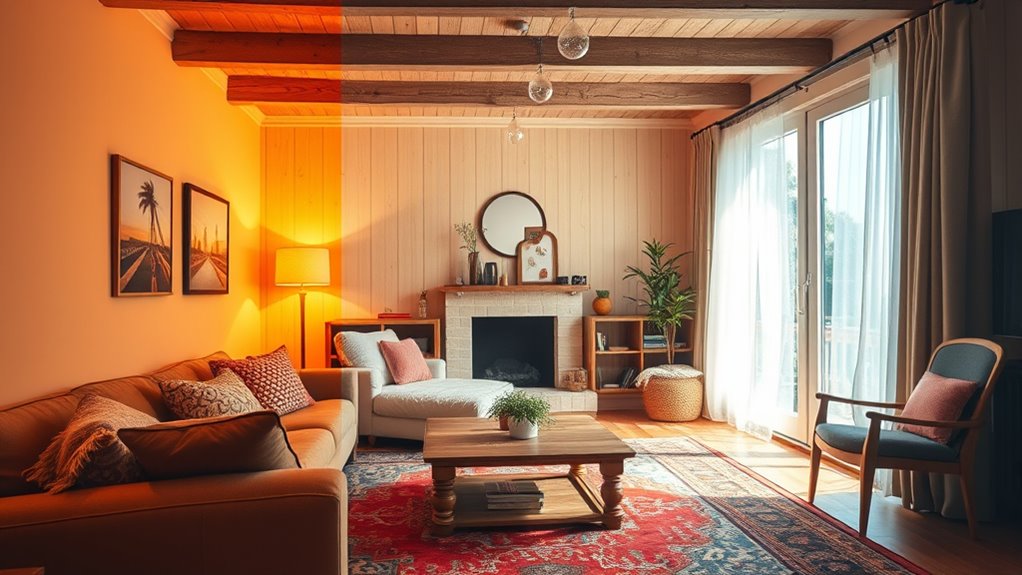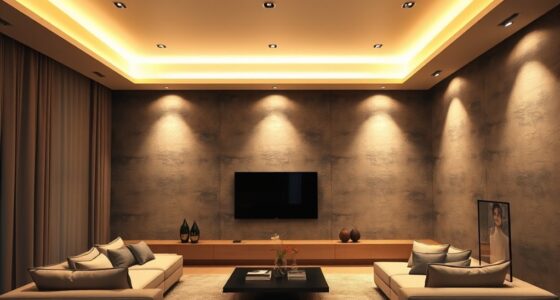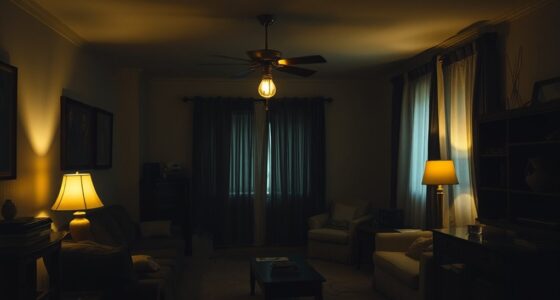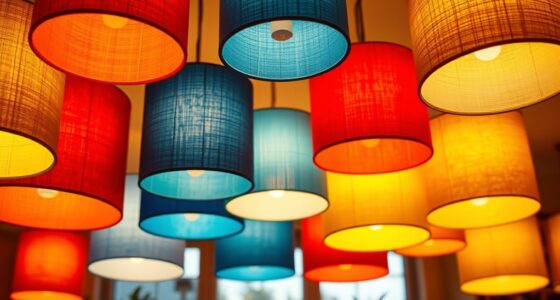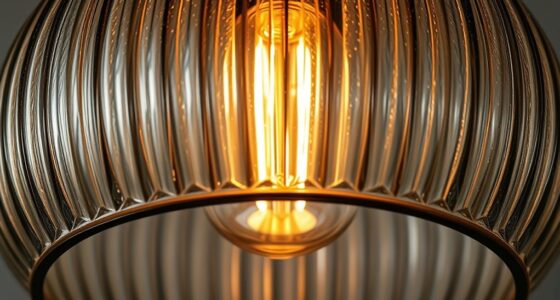The terms warm white, soft white, and daylight can be confusing because they refer to different color temperatures that affect how your space feels. Warm white (around 2700K–3000K) gives off a cozy, yellowish glow, perfect for relaxing areas. Daylight (5000K+) provides a bright, bluish light ideal for task lighting. Soft white falls somewhere in between. Understanding these differences helps you choose the right light. Keep exploring to learn more about how color temperature impacts your lighting choices.
Key Takeaways
- “Warm white” typically ranges from 2700K–3000K, producing a cozy, yellowish glow ideal for relaxing spaces.
- “Soft white” is similar to warm white, offering a gentle, inviting ambiance around 2700K–3000K.
- “Daylight” refers to higher Kelvin values, usually 5000K or above, simulating natural sunlight with a cooler, bluish tone.
- Kelvin ratings clarify color appearance, but terms like “warm white” and “daylight” may vary by manufacturer.
- Choosing between these options depends on desired mood, task needs, and the ambiance you want to create.
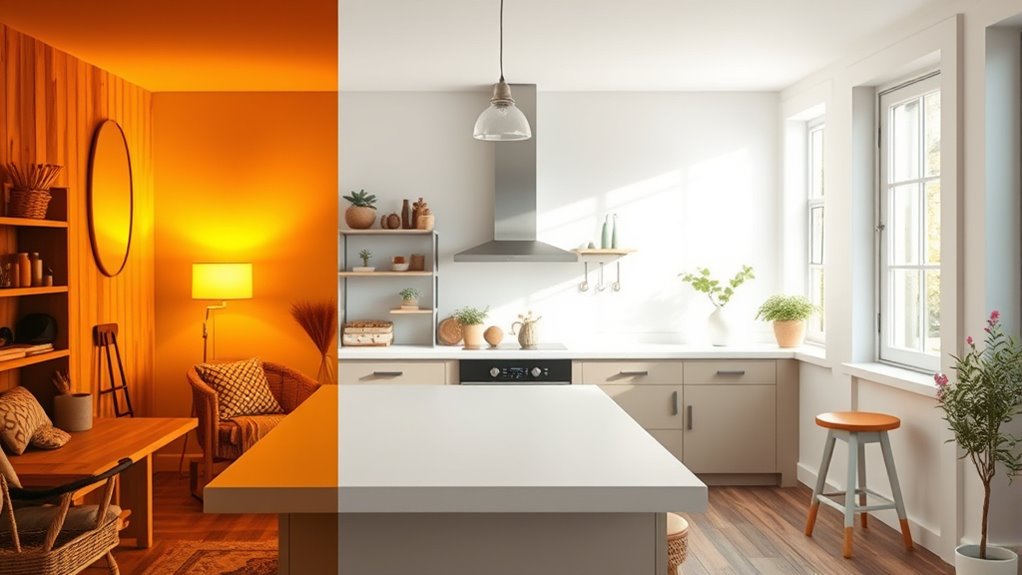
Understanding color temperature can be confusing because the terminology often overlaps and varies depending on the context. When you’re shopping for bulbs or lighting fixtures, you might notice labels like “warm white,” “soft white,” or “daylight,” but these terms don’t always mean exactly the same thing. They describe the color appearance of light, which influences how your space feels and how objects look under different lighting conditions. One key aspect to contemplate is the color temperature measured in Kelvins (K). Lower Kelvin values, typically around 2700K to 3000K, produce a warm, yellowish glow, ideal for creating cozy atmospheres. Higher Kelvin ratings, like 5000K or above, give off a cooler, bluish light, which closely resembles natural daylight.
It’s important to understand that different types of bulbs, especially LEDs, have varying lifespans and color rendering indexes (CRI). LED bulbs are popular because they last longer—often between 15,000 and 25,000 hours—compared to traditional incandescent bulbs. But the LED bulb lifespan can be affected by the quality of the bulb and how often it’s turned on and off. High-quality LEDs with a good CRI (typically 80 or higher) also provide better color accuracy, making colors appear more natural and vibrant under their light. When you choose a bulb with a high CRI, you get a more accurate representation of the colors in your home, which is particularly important in spaces like kitchens, art studios, or retail environments. Additionally, selecting bulbs with appropriate color temperature can help create the desired ambiance and improve visual comfort.
The confusion about these terms often leads to mismatched lighting that doesn’t suit your needs. For example, if you prefer a cozy living room, you might choose a warm white bulb around 2700K, but if you want bright, task-oriented lighting in your workspace, daylight bulbs at 5000K or higher are better. Keep in mind that the appearance of light can also be affected by the CRI; a higher CRI means colors will look more natural and true to life, regardless of the temperature.
Frequently Asked Questions
How Does Color Temperature Affect Mood and Productivity?
You might notice that ambient lighting impacts your mood and productivity, thanks to color psychology. Cooler light temperatures, like daylight, can boost alertness and focus, making them ideal for work. Warmer tones create a cozy, relaxed atmosphere, perfect for unwinding. By choosing the right color temperature, you actively influence your environment, optimizing both your mood and efficiency throughout the day.
Can I Mix Different Color Temperatures in One Room?
You can mix different color temperatures in one room, but it’s best to prioritize lighting consistency for a cohesive look. Use warmer tones for areas meant to feel cozy and cooler ones where you need focus. To achieve aesthetic harmony, consider using dimmers or strategically placing lights. This way, you balance variety with harmony, making your space visually appealing and functional without feeling disjointed.
What Color Temperature Is Best for Reading or Studying?
Like a lighthouse guiding sailors, choosing the right color temperature helps you focus. For reading or studying, opt for a daylight or cool white light, typically around 5000K to 6500K. These preferences mimic natural sunlight, reducing eye strain and enhancing alertness. Warm tones might feel cozy but can hinder concentration, so stick with a bright, crisp lighting environment to optimize your reading experience.
How Do I Choose the Right Bulb for Outdoor Lighting?
When selecting outdoor bulbs, consider your garden aesthetics and fixture compatibility. You want a bulb that enhances your landscape’s beauty without overpowering it. For a cozy, inviting glow, choose warm or soft white bulbs; for brighter visibility, daylight bulbs work better. Make certain the bulb fits your fixtures properly, and pick a color temperature that complements your outdoor decor and enhances safety, especially in walkways and entryways.
Are LED Lights Available in Adjustable Color Temperatures?
Oh, the joy of endless options! Yes, you can find dimmable LED lights with adjustable color temperatures, making your lighting dreams come true. These bulbs let you switch from cozy warm to crisp daylight with a flick or app, all while boasting energy efficiency. So, whether you’re setting a relaxing mood or brightening up your space, adjustable color temperature LEDs give you control and save energy—what’s not to love?
Conclusion
Understanding the differences between warm, soft white, and daylight bulbs helps you create the perfect ambiance. Did you know that about 60% of people report feeling more relaxed in warmer lighting? By choosing the right color temperature, you can boost your mood, improve focus, or create a cozy space. So next time you shop for bulbs, remember that a small switch can make a big difference in how your space feels and functions.
